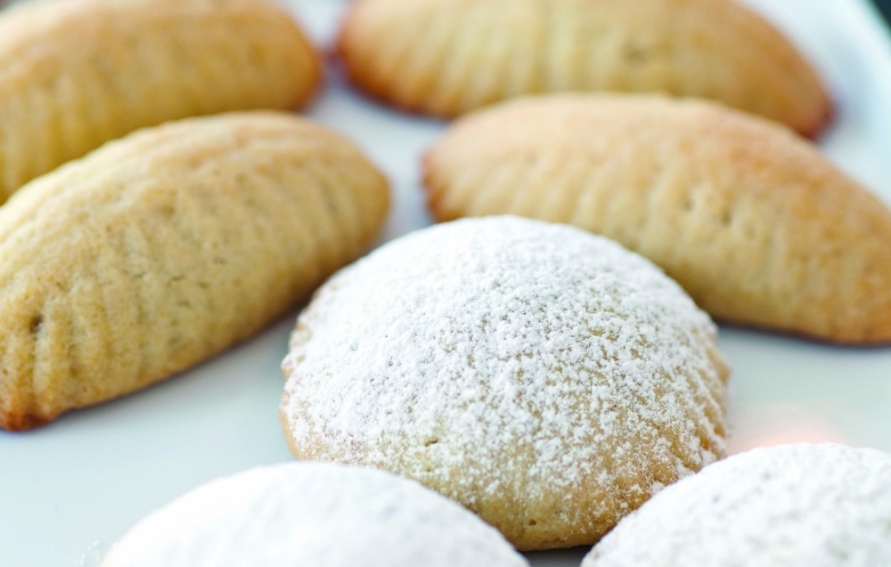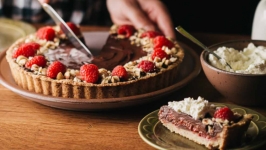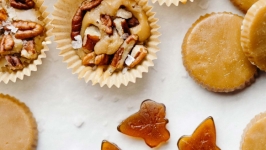Preparation
The Dough
You can make maamoul dough with all-purpose flour, but many recipes call for the addition or substitution of semolina (a coarse flour made from durum wheat, a hard or high-protein wheat) or farina (a coarse flour made from soft wheat). Helen Elia uses a mix of semolina and farina in her maamoul. Heba Said makes her maamoul with cake flour, which she finds makes the dough very tender.
Some recipes use a small amount of yeast in the dough. Instant yeast, which I used in these recipes, does not need to be dissolved in liquid prior to mixing with other ingredients. If you do not have instant yeast, mix the yeast with the water or milk called for in the recipe before adding to the other ingredients. Orange blossom or rose water adds a subtle floral perfume to most maamoul recipes. Some cooks, especially in Lebanon, also season their dough with mahlab, a spice made from ground cherry stones with a bitter almond flavor.
Maamoul are almost always made with butter, but some cooks combine butter with vegetable oil, margarine or shortening. An essential ingredient with some bakers is clarified butter or “ghee” (the fat left over after the milk solids and water have been removed), which gives the dough a greater depth of flavor and helps preserve the cookies. (Heba Said says clarified butter is traditional in Sudan and keeps the cookies fresh for up to three weeks.) You can easily make ghee at home, but make sure you start with more butter than the amount of ghee called for in the recipe (e.g., 1 cup of butter will make approximately ¾ cup of ghee). Bring the butter to room temperature, then melt it in a heavy saucepan and skim off the white foam until all that remains is clear, yellow butterfat.
Both dough recipes that follow make approximately 24 cookies (depending on size).
Semolina Dough
If you would like to try using tabbeh, this recipe is best.
Ingredients:
2 cups semolina
½ cup white flour
½ cup sugar
1 teaspoon instant yeast
⅛ teaspoon salt
½ cup melted ghee, cooled but still liquid
4 teaspoons orange blossom or rose water
½ cup water
Sift and stir together semolina, flour, sugar, salt and yeast. Add ghee, flower water and water. Blend by hand until well mixed. Dough will appear greasy. Cover and let dough rest 1–3 hours. Dough can also be refrigerated overnight if desired, but you should let it soften a bit at room temperature and knead gently before forming cookies.
Cake Flour Dough
This version, inspired by Heba Said’s recipe, is tender and flaky, but too soft to use with tabbeh. Its high proportion of fat to flour makes it tricky to handle, so it is recommended for experienced bakers. Like with piecrust, you should avoid over-handling, which causes the dough to soften and become unmanageable. If the dough gets too soft, put it back in the fridge to firm up.
Ingredients:
2 cups cake flour (if you do not have cake flour, put 2 tablespoons cornstarch in each measuring cup prior to adding flour)
2 tablespoons sugar
2 teaspoons instant yeast
⅛ teaspoon salt
1 cup melted ghee, cooled but still liquid
4 tablespoons milk
2 tablespoons orange blossom or rose water
Sift and stir together flour, sugar, salt and yeast. Add ghee, flower water and milk. Blend by hand until well mixed. Dough will be very sticky and soft. Cover and refrigerate 30–45 minutes until dough has firmed up, but not so long that the dough becomes hard and unworkable.
Instructions
Maamoul Fillings
Maamoul filling is generally made from dates, walnuts or pistachios mixed with sugar and flavorings like orange blossom or rose water and occasionally cinnamon or cardamom. An Iraqi version of maamoul, known as kleicha is richly spiced and sometimes also includes aniseed, nigella, coriander and sesame. In Sudan, Said says, some people like to fill maamoul with a piece of Turkish delight, a soft and chewy candy flavored with mastic (a pine-flavored tree resin), rosewater or nuts.
The recipes that follow make enough filling for approximately 2 dozen maamoul.
Walnut Filling
If you’re making this filling and want to use local organic walnuts, you can get them from farmer Beth Tollas, whose family has been growing English walnuts in Baroda, Michigan, for 25 years. Tollas sells at the farmers market in St. Joseph, Michigan, and at the Tabula Rasa Gallery in Baroda. organicenglishwalnuts.com
Ingredients:
2¼ cups finely chopped walnuts
½ cup sugar
3 tablespoons orange blossom water or rose water
Blend ingredients to make a paste.
Date Filling
Ingredients:
13 ounces pitted dates, puréed, or date paste (aka “baking dates”)
2 tablespoons water, as needed
1 tablespoon orange blossom or rose water
½ teaspoon ground cinnamon
Blend ingredients to make a paste.
To Form the Cookies:
Pinch off a piece of dough no bigger than a golf ball. Roll into a ball or oblong shape with your hands. Using a rolling pin, flatten dough on a piece of wax paper or plastic wrap to a bit thicker than ⅛ inch. For cake flour dough, it is best to place dough between 2 layers of wax paper to roll it out. Do not worry about the exact shape of the flattened dough or about ragged edges.
If forming cookies by hand: Spoon 1 tablespoon filling into center of dough as if making a dumpling. Fold up and seal edges with your fingers. Shape cookie with your hands into an oblong or circle. Avoid tearing dough. Patch tears by using your fingers to smooth the dough. Do not worry about making perfectly shaped cookies. You can gently reshape them once they are on the cookie sheet.
If using tabbeh: Gently transfer flattened dough to mold. Spoon approximately 1 tablespoon filling into dough pocket. Carefully seal edges together and flatten bottom of cookie, pushing dough into mold and pinching off any excess dough. Remove cookie from mold by tapping mold on table or loosen with a knife. (Some people advise slamming the mold on the table, but this can be noisy!)
Place cookies 2 inches apart on a parchment paper–covered baking sheet. Bake at 350° for 20 minutes. Cookies should be lightly browned on the bottom, but still pale or only very lightly browned on top. Walnut maamoul are traditionally sprinkled with powdered sugar after baking, which makes them look especially pretty, but is not essential. Date maamoul are typically served plain.
About this recipe
Recipe Sources
Walnut and date fillings based on recipes from Recipes and Remembrances from an Eastern Mediterranean Kitchen by Sonia Uvezian.
Semolina dough modified from a recipe on the blog Mahanandi: Cooking with Consciousness.
Cake flour dough recipe inspired by Heba Said.
Maya Parson is a recent transplant to Michiana and convert to the joys of eating local pastured meats and farm-fresh milk and eggs. A cultural anthropologist and home cook, she has enjoyed living and eating in Northern California, the Pacific Northwest, the Basque country, Nicaragua, North Carolina and on Long Island. She can be found most Saturday mornings at the Goshen Farmers Market.








